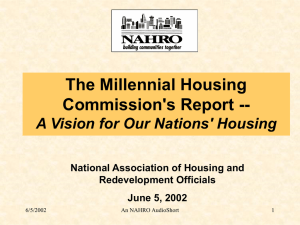Presentation
advertisement
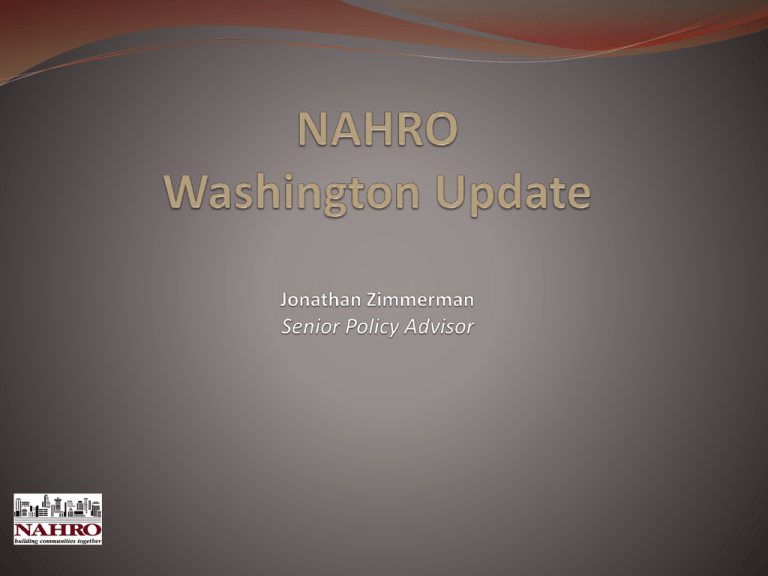
Housing Assistance Payment and Ongoing Administrative Fee ProRations & Voucher Lease-up Rates 105% 100% 100% 100% 100% 100% 101% 100% 96% 99% 97% 95% 92% 91% 90% 90% 89% 91% 90% 92% 92% 93% 100% 99% 92% 93% 91% 90% 88% 87% 85% 100% 94% 90% 85% 80% 80% 75% 70% 69% 65% 2003 2004 2005 2006 Voucher Lease-up Rate 2007 2008 2009 2010 2011 2012 Housing Assistance Payment Pro-ration 2013 2014 Iron Triangle / Triple Constraint Both pro-rations for administrative fees and Housing Assistance Payments in FY 2013 as appropriated by Congress, are the lowest in the 38 year history of Section 8 voucher programs. Downward pro-rations in HAP adversely impacts PHAs’ ongoing administrative fee revenues and downward pro-rations in PHAs’ ongoing administrative fees adversely impacts their ability to serve low-income households and participating property owners. Over the past decade, PHAs have received on average approximately 87 percent of their annual ongoing administrative fee funding from Congress and HUD each year. As a result of dramatic funding reductions, many PHAs are in a very difficult position of having to limit and reduce their program service and performance. The cost, scope, time and schedule requirements necessitated by existing voucher program regulations and HUD assessment systems have inherent competing constraints that impacts quality. Iron Triangle / Triple Constraint The project management triangle (also called the Triple Constraint or the Iron Triangle) is universal to all industries and sectors, including in a government measurement and program oversight context. Over the years, senior HUD PIH officials presented this triangle and the governing concepts to NAHRO members during their presentations at our annual legislative conferences. It is incumbent upon HUD not to micromanage local operations and impede PHAs’ mission to serve lowincome households to the greatest of their abilities with the funding provided. Instead, HUD should move quickly to limit risk and measure key program outcomes in a way that harmonizes the inherent limitations in cost, scope, time and schedule requirements. “Making Difficult Tradeoffs” On May 30, 2006, the Government Accountability Office (GAO) released a report, Policy Decisions and Market Factors Explain Changes in the Costs of the Section 8 Programs ' (GAO-06-405), that clearly illustrates the tradeoffs in funding policies considered by Congress. The report states “The cost of providing rental assistance has been a longstanding issue for policymakers and has led Congress, on different occasions, to reform various housing programs… To the extent that policymakers wish to stem the rising cost of the voucher program, our analysis suggests that future increases could be mitigated by reducing the number of assisted households, lowering payment standards, requiring households to pay a larger share of their incomes toward rent, subsidizing households with higher incomes, or a combination thereof. However, these actions require making difficult trade-offs between limiting program costs and achieving long-standing policy objectives, such as serving more needy households, having assisted households pay a relatively small share of their incomes in rents, making it easier for voucher holders to find housing (especially in tight rental markets), reducing the concentration of poverty, and giving PHAs the flexibility to respond to local rental market conditions.” “Making Difficult Tradeoffs” GAO’s report goes on to note that, while both “Congress and HUD have already responded to the increasing cost of vouchers by changing the way the program is funded. Specifically, HUD no longer provides funding to PHAs based on the number of authorized vouchers, but rather based on the prior year's level of voucher expenditures, adjusted by an inflation factor. While this approach allows HUD to limit the annual rate of increase in the program's cost, [but] it does not directly address the policy decisions and market factors that we identified as contributing to the increase in program costs. Instead, it will be up to PHAs to exercise their flexibilities and make decisions regarding how to use the voucher funding that they receive from HUD.” It then goes on to provide examples of ways that PHAs can limit the growth in voucher costs, “For example, some PHAs may choose to reduce their local payment standard, a course that, as our analysis suggests, would likely limit growth in voucher costs. The decisions that PHAs make will eventually influence trends in outlays, per household subsidies, and unit rents, and these trends will become more apparent in the years following the period covered by our analysis.” Section 8 Appropriations FY 2013 FY 2014 Enacted Proposed House Senate $17,964 $19,989 $18,611 $19,592 Section 8 HAP Renewals [$16,349] [$17,968] [$17,000] [$17,568] $18,540 Ongoing Administrative Fees [$1,258] [$1,635] [$1,335] [$1,670] $1,994 Additional Administrative Fees [$48] [$50] [$15] [$15] $50 Tenant Protection Vouchers [$71] [$150] [$75] [$150] $150 Incremental HUD-VASH Vouchers [$75] [$75] [$75] [$78] $75 [$57] $75 $60 $75 $87 $8,8521 $10,272 $9,451 $10,772 Fully Fund NAHRO Program ($ Millions) Tenant-Based Rental Assistance FSS Coordinators Sec. 8 PBRA 6 Percent Cut in Housing Assistance Payments Renewals in FY 2013 many PHAs have had to lease fewer low-income households including rescinding vouchers from those in the housing search process and not being able to lease “turnover” vouchers; resulting in a national voucher lease-up rate of 93 percent in 2012 to as low as 86 percent by 12/31/13; Annual per voucher costs per household are substantially less than annual shelter cost per household greater numbers of voucher-assisted households have experienced higher income to housing cost burdens (income to rent and utility allowances or expenses); and increase waiting times for eligible unassisted households on their waiting lists. 6 Percent Cut in Housing Assistance Payments Renewals in FY 2013 Anecdotally, we have heard from our PHA members: that participating property owners have not renewed their existing dwelling leases with voucher-assisted low-income housing-assisted households due to the appropriations risk as well as having all annual rent increase requests frozen for six months, in favor of higher income households in the private market and prospective property owners are choosing not to participate in the Section 8 voucher program for the same reason; a significant loss of available and affordable housing units to extremelylow-income and very-low-income households that has prevented voucher-assisted households from leasing decent, safe, sanitary and affordable housing units; and voucher-assisted households living in greater concentrations of poverty and living in dwelling units with relatively lower quality housing stock. 31 Percent Administrative Fee Cut in FY 2013 Since administrative fee earnings for each PHA are based on the number of voucherassisted households leased, as the total number of low-income households leased in voucher programs has decreased in 2013 it has undermined the maximum number of households PHAs could have otherwise leased with the total HAP-related funds available to them. Under an annual rebenchmarking voucher HAP renewal formula for FY 2014 this will lead to a continuation of the “downward spiral” in FY 2013; Higher proportional reductions in the average number of voucher program staff, corresponding with higher caseload sizes and HQS inspection volumes per staff, higher turnover of voucher staff, higher errors in eligibility determinations and rent calculations due to not having enough staff to handle the workload, overdue recertifications, and improper payments; Reduction in the families served who require intensive service coordination including homeless veterans, at-risk youth, and disaster victims. With great anguish, more and more PHAs have had to decline incremental HUD-VASH voucher awards, as a direct result of administrative funding levels that are insufficient to administer this important program. 31 Percent Administrative Fee Cut in FY 2013 PHAs have “handed back” their voucher programs to HUD or transferred them to another PHA. Continued PHA staff layoffs, furloughs, reduction of work days, and not filling vacated positions have led: to a corresponding reduction and elimination of activities such as program integrity measures and fraud recovery, discretionary interim income and rent re-examinations and other voucher program functions; and a reduction in briefings, issuing vouchers, assisting in housing search, conducting HQS inspections and the overall lease-up processes are time and labor intensive. Ongoing Administrative Fee Pro-Rations 100% 93% 90% 88% 85% 80% 80% 70% 69% 60% 50% 2009 2010 2011 2012 2013 PHAs Handing Back Voucher Programs Since FY 2003 - the last year that PHAs’ received full administrative funding – 213 PHAs, or 9 percent of all PHAs administering voucher programs, have “handed back” their voucher programs to HUD or transferred them to another PHA. When this happens, there is a loss of the kind of services provided by local PHAs and it adversely affects PHAs’ ability to maintain the number of low-income households leased while fully utilizing the rental housing subsidy funds available. Number of PHAs That Have Handed Back Their Voucher Program to HUD or Transferred to Another PHA 60 52 50 40 30 29 25 24 20 16 10 0 2009 2010 2011 2012 2013 (estimate based on 1st Quarter) Household Caseload Size Average Per PHA FTE Voucher Program Staff 400 350 360 342 300 250 200 226 238 234 216 212 205 150 100 2004 2005 2006 2007 2008 2009 Number of Voucher-Assisted Households Per FTE Voucher Staff 2010 2011 Program Gross Rent Error Rates: Section 8 Tenant-Based Voucher vs. Project-Based Sec. 8 Multi-family Assistance Program 14% 12% 12% 11% 10% 10% 10% 9% 8% 8% 9% 9% 8% 8% 7% 6% 7% 6% 5% 5% 4% 4% 2% 0% 2004 2005 2006 2007 2008 2009 2010 2011 GRE Rate HCV GRE Rate MFH Program Dollar Rent Error: Section 8 Tenant-Based Voucher vs. Project-Based Sec. 8 Multifamily Assistance Program $25 $23 $22 $20 $20 $20 $20 $19 $18 $17 $16 $15 $15 $14 $13 $13 $12 $11 $10 $7 $5 $0 2004 2005 2006 2007 2008 2009 2010 2011 GDRE $ HCV GDRE $ MFH 5.0 Staffing in FY 2011: Ratio of Section 8 Tenant-Based Voucher Program to Project-Based Section 8 Rental Assistance Program 4.5 4.3 4.0 3.5 Mistakes in Calculating Rent Overdue Re(Certifications) 3.0 2.5 2.0 Not Having Enough Staff to Handle the Workload 1.5 1.8 1.6 1.5 1.4 1.0 1.1 0.5 Complex HUD Regulations for Rent Calculations The PHA/Projects with (Re)Certification Staff Who Left the PHA Project 0.0 A 4.3 to 1 ratio (4.3:1) means that an occurrence in a particular area of the Section 8 Tenant-Based Rental Housing Voucher program is 4.3 times the rate of this type of occurrence, when compared with the Project-Based Section 8 Rental Assistance program. FY 2014 - Section 8 Tenant-Based Housing Assistance Programs Pro-Rations Base Voucher Housing Assistance Payment (HAP) Funds: During the House Appropriation Committee’s mark-up of the bill, Rep. Ed Pastor (D-Ariz.) cautioned his colleagues by saying that the $17 billion funding level for FY 2014, already assumes the reduction of approximately 100,000 fewer voucher-assisted households in calendar 2013 due to cuts under the sequester. Section 8 Ongoing Administrative Fees: What’s At Stake between House and Senate FY 2014 THUD Appropriation Bills? Base Voucher HAP Renewal Formula – “Downward Spiral” HAP Set-Aside Fund NAHRO’s Recommended HAP Set-Aside Fund Adjustments to PHAs’ Base Voucher HAP Renewal Funding and HAP Eligibility Reduction Measures: For both non-MtW and MtW PHAs, both bills adopt HUD’s FY 2014 budget proposes a series of HAP eligibility reduction measures including: 1) broadening the definition of “extremely low-income” to apply to families with incomes that are the higher of 30 percent of area median income or the federal poverty level ($155 million); and 2) determining utility allowances based on the bedroom size of the voucher for which a household qualifies under the PHA subsidy standards regardless of size of unit leased ($50 million) Impacts on PHAs’ HAP Funding as it relates to elderly and disabled households income to rent and utility burdens Senate Appropriation Committee’s FY 2014 THUD Bill (S. 1243) Senate Appropriations Committee FY 2014 bill (S. 1243) includes the following provisions: Revised definition of ELI households Biennial HQS inspections Other passed inspection in lieu of PHA HQS inspection for both initial units and existing voucher-assisted units Utility allowances NAHRO’s Action Alert & Washington Update Media clips illustrating examples of the adverse impacts of the sequester are available at: http://www.nahro.org/local-and-national-news Please access NAHRO’s Washington Updates for our Action Alerts at: http://www.nahro.org/news-content/your-advocacy-needed%E2%80%9Cstorm%E2%80%9D-hill-tuesday Please access NAHRO’s Advocacy Action Center for additional education and advocacy materials at: http://www.nahro.org/nahro-advocacy Glacial Pace of Regulatory Reform and Relief Consistent submission of recommended relief measures each year for a decade During a period of insufficient funding, we made joint recommendations with PHADA and CLPHA to HUD which include but are not limited to temporary/interim relief non-statutory elements of SEMAP and PHAS and to make the scores advisory NAHRO’s Voucher Program Resources On March 22, 2013, NAHRO’s Policy and Program Development Division held a two-part PolicyView eBriefing to help PHAs deal the best they can with the draconian voucher program cuts in FY 2013 under the circumstances. NAHRO’s archived webinars and accompanying materials are located at: http://www.nahro.org/news-content/updated-nahroposts-archived-voucher-program-webinars Public Housing Appropriations FY 2013 FY 2014 Enacted Proposed House Senate NAHRO Public Housing Operating Fund $4,054 $4,600 $4,262 $4,600 $5,168 Public Housing Capital Fund $1,777 $2,000 $1,500 $2,000 $3,750 ROSS Program [$47] $0 $0 [$50] $50 Jobs Plus Pilot - [$15] [$15] [$15] [$19] [$20] [$20] [$20] $20 $114 $400 $0 $250 $400 - $10 $0 $10 Program ($ Millions) Emergency Capital Needs Choice Neighborhoods Initiative Rental Assistance Demonstration Supportive Services Combined FSS Both House and Senate bills would combine funding for FSS coordinators Jobs-Plus Pilot Both bills: $15 million Capital Fund set-aside for “competitive grants to partnerships between PHAs and local workforce investment boards or other agencies” ROSS No funding in House bill How we got here House: Total spending level of $967 billion T-HUD bill passed out of committee, crashed and burned on floor, withdrawn Senate Total spending level of $1.058 trillion T-HUD passed out of committee, floor vote blocked $10 billion difference in T-HUD bill alone
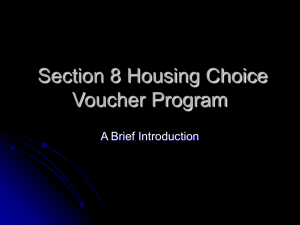
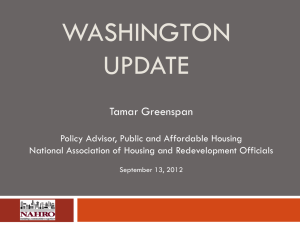



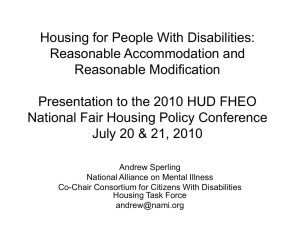
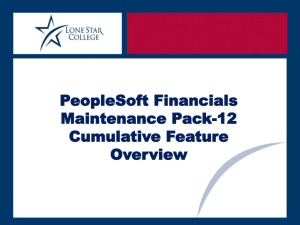
![RAD PPT Michigan Presentation 5.9.13.ppt[...]](http://s2.studylib.net/store/data/005346357_1-710f69a00abbbbdd4222e30f9215f0c5-300x300.png)

